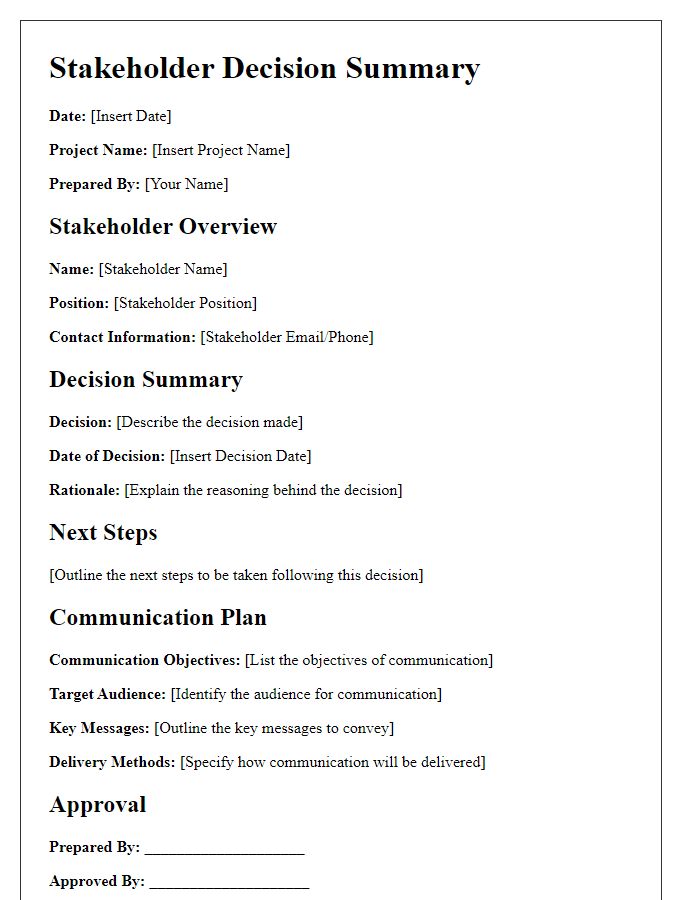In the world of business, clear communication with stakeholders is essential, especially when summarizing important decisions. A well-structured letter template can help convey crucial information succinctly and effectively, ensuring that everyone is on the same page. Whether it's a project update, policy change, or strategic direction, the right format can make all the difference in maintaining transparency and fostering trust. Ready to dive deeper into the nuances of crafting the perfect stakeholder decision summary? Read on!

Clear objective and purpose statement
Stakeholder decision summaries provide a concise overview of key objectives and the purpose behind major decisions impacting a project. These documents often reflect collaborative discussions among project leaders, financial analysts, and various stakeholders. The objective typically centers on aligning project goals with stakeholder expectations and resource allocation. A well-defined purpose statement highlights the intended outcomes of the decision, emphasizing how it supports strategic initiatives or mitigates risks. For instance, establishing a partnership with a local technology firm could enhance product development efficiency, thereby driving revenue growth and improving market competitiveness in 2024. Comprehensive summaries not only encapsulate decisions made but also outline rationales, ensuring transparency and fostering trust among stakeholders.
Key decision points and rationale
Key decision points and rationale regarding stakeholder engagement in project management delineate the critical moments where stakeholders influence project outcomes. Identifying decision points, such as budget approvals (e.g., a $500,000 allocation for Q2 initiatives), project scope changes (e.g., extending deliverables to include user feedback mechanisms), or timeline shifts (e.g., delaying launch from June to September 2024) is essential. Rationale incorporates stakeholder needs, including prioritizing community input through surveys, aligning project goals with organizational objectives (e.g., sustainability targets), or addressing risk management strategies (like contingency plans for budget overruns). Clear documentation of these elements fosters transparency and informed discussions among stakeholders.
Impact analysis and stakeholder implications
Impact analysis for stakeholder decisions involves assessing how specific choices (such as project investments of $500,000) affect various groups (including local communities and investors). Understanding implications requires evaluating potential changes in operations, regulatory compliance (such as adherence to environmental laws), and financial outcomes (like projected revenue increases of 15%). Effective engagement strategies (surveys, focus groups) should be formulated to gather feedback from stakeholders (employees, customers) to ensure their views are considered. Additionally, identifying key risks (such as market fluctuations) and establishing contingency plans can support long-term sustainability (enhancing brand reputation and trust) while fostering positive relationships with all stakeholders involved in the decision-making process.
Summary of supporting data and insights
Stakeholder decision summaries require comprehensive insights and data to support informed decision-making. This summary should encompass quantitative metrics, qualitative feedback, and trends identified through research, focusing on particular initiatives or projects. For instance, leveraging market analysis reports from 2022 reveals a growth rate of 15% in eco-friendly products within the retail sector, highlighting a shift in consumer preferences. In addition, surveys conducted among 500 consumers indicate that 70% prioritize sustainability in purchasing decisions, underscoring the importance of eco-conscious strategies. Furthermore, competitive analysis showcases successful case studies from organizations like Unilever, which implemented sustainable practices, resulting in a 25% increase in brand loyalty. These insights collectively inform strategic planning, ensuring alignment with stakeholder objectives and market demands.
Call to action and next steps
A comprehensive stakeholder decision summary emphasizes the importance of collaboration in driving project success. It details key outcomes of recent meetings on critical initiatives, such as the upcoming project launch scheduled for Q1 2024, and outlines areas requiring urgent attention, such as resource allocation and timeline adjustments. Active participation from stakeholders, including department heads from Marketing and Operations, is vital to address these challenges. The summary also highlights next steps, including scheduled follow-up meetings on February 15, 2024, and the establishment of a task force to streamline communication channels, ensuring all parties are aligned and informed. Engaging stakeholders in these efforts fosters a proactive approach toward achieving the project's objectives.
Letter Template For Stakeholder Decision Summary Samples
Letter template of Stakeholder Decision Summary for Resource Distribution













Comments